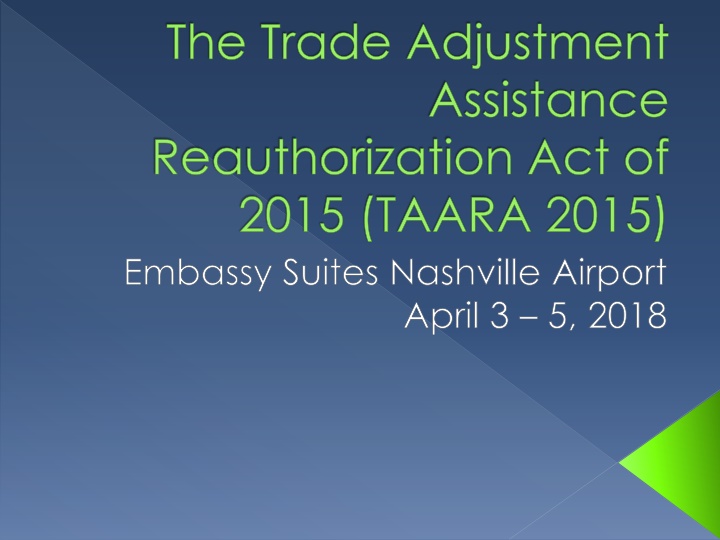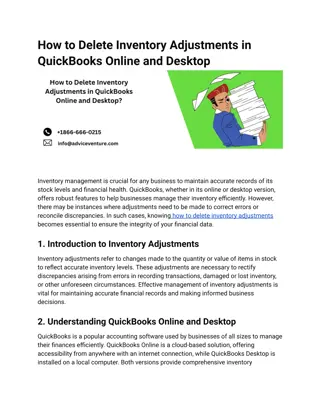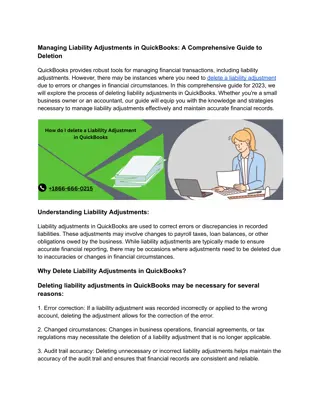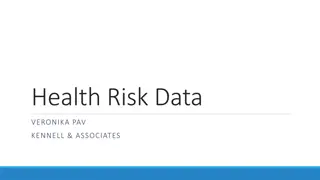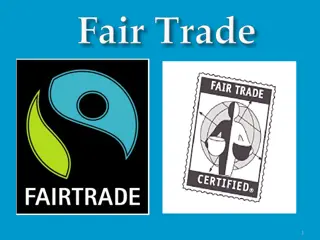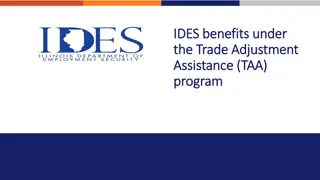TAARA 2015 Trade Adjustment Assistance Reauthorization Act
The Trade Adjustment Assistance Reauthorization Act of 2015 (TAARA 2015) provides support to workers affected by increased imports or shifts in production to foreign countries. It offers job training, weekly benefits, and Health Coverage Tax Credit (HCTC). Acronyms like TRA, TAA, HCTC, and RTAA play a significant role in providing assistance to eligible individuals. Contact the Nashville TRA Unit for more information and benefits.
Download Presentation

Please find below an Image/Link to download the presentation.
The content on the website is provided AS IS for your information and personal use only. It may not be sold, licensed, or shared on other websites without obtaining consent from the author.If you encounter any issues during the download, it is possible that the publisher has removed the file from their server.
You are allowed to download the files provided on this website for personal or commercial use, subject to the condition that they are used lawfully. All files are the property of their respective owners.
The content on the website is provided AS IS for your information and personal use only. It may not be sold, licensed, or shared on other websites without obtaining consent from the author.
E N D
Presentation Transcript
The Trade Adjustment Assistance Reauthorization Act of 2015 (TAARA 2015) Embassy Suites Nashville Airport April 3 5, 2018
NASHVILLE TRA UNIT Tennessee Department of Labor and Workforce Development TRA Unit P.O. Box 280450 Nashville, TN 37228 1-877-813-0950 tra.claims@tn.gov
NASHVILLE TRA STAFF Melissa Carter Manager 615-532-1196/melissa.carter@tn.gov Jillian Hedgepath Manager 615-770 - 5337/jillian.hedgepath@tn.gov Marcus Warren RTAA 615-770-5347/marcus.l.warren@tn.gov Angela Carnahan TRA Certifications/Training 615-837-5444/angela.carnahan@tn.gov Amanda Stephens RTAA Backup 615-770-1860/amanda.stephens@tn.gov Chris Burton TRA Certifications/Training Backup 615-837-5553/christopher.burton@tn.gov
BENEFITS OF TRA Individuals who qualify for TRA may receive: Job Training Weekly Benefits RTAA HCTC- Health Coverage Tax Credit
Acronyms and Definitions TAARA Trade Adjustment Assistance Reauthorization Act of 2015 - available to workers who lose their jobs or whose hours of work and wages are reduced as a result of increased imports or a shift in production to a foreign country. Workers may be eligible for training, job search and relocation allowances, and re-employment services. Additionally, TRA may be payable to eligible workers following their exhaustion of unemployment insurance benefits. TRA- Trade Readjustment Act- Income support to individuals while they are participating in full time training or to certified workers for whom training is not feasible or appropriate. TAA- Trade Adjustment Assistance- Training, mileage reimbursement while in training, job search and relocation allowances and re-employment services.
Acronyms and Definitions HCTC- Health Coverage Tax Credit- A tax credit equal to a % of the premium paid by eligible individuals for qualified health insurance. HCTC is available to those claimants who have a TRA Diminishing Balance and 1) Receiving TRA Benefits, 2) Who would be eligible for TRA but have not exhausted their regular unemployment compensation benefits, or 3) Receiving wage subsidies through RTAA/ATAA. RTAA- Reemployment Trade Adjustment Assistance - Provides eligible individuals age 50 and over who obtain new employment with a wage subsidy to help bridge the salary gap between their old and new employment. Individuals meeting the qualifications may receive up to 50% of the difference between their former annualized wage and new wage.
TAARA of 2015 26 weeks for waiver and training requests Basic TRA Payments Up to 65 Weeks of Additional TRA Payments Completion TRA and Benchmarks RTAA HCTC
Who is eligible for TAARA 2015 1) Company employee worked for must be covered under an approved Petition. A list of petitions (Pending, Approved, Denied) can be found at: https://www.doleta.gov/tradeact/ 2) Claimant must have been partially or totally separated or threatened to be separated at a future date due to a LACK OF WORK from that company on or after the impact date of the petition
Applying for TAA/TRA The first thing an applicant must do to apply for TAA/TRA is come into the office and speak with their TAA Representative to discuss training needs and goals Next, the claimant needs to be sure to register with our department on jobs4tn.gov.
When should Applicant apply for TRA? If applicant is interested in HCTC, they need to apply for TRA (HCTC Eligibility will be discussed later in these slides) If applicant has exhausted Regular Unemployment Benefits and he/she is pursuing training, they need to apply for TRA - REMEMBER an applicant only has 26 weeks from their final separation or 26 weeks from the certification of the TRA petition to make a timely request for training and be eligible to receive TRA monetary benefits.
How to apply for TRA TRA Claims will need to be taken by the TRA Reps at the American Job Center We no longer take TRA Claims in person TAA Rep will need to get a good daytime phone number for the claimant Let them know they will be contacted between 7:00 AM and 3:30 PM Central Time Monday Friday (Try and get a couple of windows of time for the TRA Agent) TAA Rep will need to email Angela Carnahan and Copy Marcus Warren and Melissa Carter letting them know to contact the claimant.
Waivers As mentioned earlier, the claimant has 26 weeks to make a timely request for training and 26 weeks to sign a waiver. If the claimant has exhausted regular UI, they can draw Basic TRA up to their 26 weeks before signing a waiver. If claimant is not in TAA Approved training, they must continue to do work searches each week.
Where To Find The Waiver & Waiver Deadline It is the responsibility of TAA Staff to issue the Waiver Staff can find the Waiver Deadlines in VOS (see the next slide) The TAA Unit will issue waivers through VOS Must print from VOS and have claimant sign a copy and scan into VOS with the signature
WAIVERS Waiver granted under the following criteria: Health- The worker is unable to participate due to workers health but must be able to work, seek, and accept suitable work under Federal or State law. (proper documentation must be provided ) Enrollment Not Available- The first available enrollment date for the approved training for the worker is within 60 days after the date of the waiver, or there are extenuating circumstances that will delay training enrollment beyond 60 days. (the expectation is that the claimant will enter training later) Training Not Available- Training is not reasonably available to the worker from either governmental agencies or private sources that meets the workers needs and can be funded using existing funding sources.
Waiver Reasons Health the only way a waiver can be issued for Health is if the claimant has a note from their Doctor stating they are not physically able to do training, but, they are able and available to work FT. You must have a note in the file from the Doctor to accompany the Waiver Training Not Available This would be issued if there is not a training facility available to the claimant and it is VERY RARE that you would use this Enrollment Not Available This is if the claimant has made application to a training facility and is on a waiting list or has a start state that is AFTER their Waiver Deadline. This is the most common reason you will use when issuing a waiver.
When is a Waiver Necessary Waivers do not need to be issued until the waiver deadline Claimant MUST have proof from the training facility they have made a request for training and have a start date or have been placed on a waiting list BEFORE you issue the waiver. Only if the claimant did this prior to the 26 week deadline can you issue the waiver (even if they are presenting the proof after the deadline)
When is a Waiver Necessary If TAA approved training enrollment date is prior to the waiver deadline no waiver will be required. If TAA approved training enrollment date is after the waiver deadline a waiver with Enrollment Not Available marked should be issued. If the claimant FAILS to start training and the agency or school is not at fault, the waiver must be REVOKED in VOS so that claimant is not paid benefits to which they are not entitled and creates an overpayment.
Types of TRA Payments Up to 26 weeks of UI Basic TRA (The amount of weeks and the $ amount depends on the UI Claim Can be more than 26 weeks) 65 Weeks of Additional to be drawn out over 78 Weeks (to account for breaks) 13 Weeks of Completion TRA to be drawn out over 20 Weeks (to account for breaks) 52 weeks (UI + Basic) + 65 Additional + 13 Completion =130 Weeks of Income Support Possible
The 5 Criteria for Completion TRA There are 5 requirements which must be met each week while drawing Completion TRA. If during a week a claimant fails to meet all 5 requirements, the state may no longer pay the worker Completion TRA. The requested weeks are necessary for the worker to complete a training program that leads to a degree or industry-recognized credential; as described in TEGL 15-10, and, The worker is participating in training in each such week, and The worker has substantially met the performance benchmarks established in the approved training plan; and The worker is expected to continue to make progress toward the completion of the approved training, and The worker will be able to complete the training during the period authorized for receipt of Completion TRA. If the claimant DOES NOT COMPLETE their training in 20 weeks after beginning to draw Completion TRA, they will be overpaid for the completion TRA they have drawn. Claimant does not have to begin Completion TRA immediately following Additional TRA. They must wait to apply for it until they are within 20 weeks of completing training. 1. 2. 3. 4. 5.
Completion TRA Up to 13 weeks of Completion TRA may be granted to a claimant that will allow them to complete training that leads to a degree or industry related credential. Completion TRA requires the claimant to complete the Request for Completion TRA Benefits LB-1106. If the claimant becomes Non Compliant they are required to sign the Participant Non- Compliance Warning LB-1107.
School Certifications TRA Claimants can do their certifications on line at Jobs4tn.gov or mail/fax/upload the appropriate certification to the TRA Unit and we will input the certification for them (Job Seekers and TAA Approved Training) TRA claimants attending training MUST submit the 858-A for weekly certification to verify the claimant is in attendance at their training facility. A signature is required (must be authorized by Signature of Authority) BUT the form can now be Faxed/Emailed/Uploaded in VOS. It does not have to be mailed anymore. The TAA Staff will need to provide the claimant with the form upon approval of training. TAARA provides that for the workers participating in approved full time training, no deduction is made for earnings from work for a week up to an amount that is equal to the worker s most recent TRA benefit amount plus earnings allowance (this only applies once a claimant begins drawing TRA benefits). To ensure claimants receive all benefits, American Job Center staff must amend training dates in VOS if required. TRA payment cannot be made to claimants if their Eligibility Period Ends, if in additional weeks and complete school, or they drop out of school.
When is it necessary to do Work Searches under TRA If the claimant does not intend on participating in TAA Approved training but they have not yet reached their Waiver Deadline and their UI has exhausted, they can draw TRA Basic up until their waiver deadline but they are required to do work searches. Again, they can certify through jobs4tn.gov and record their work searches there each week just as they do while drawing UI or send the Worker Not in Training Certification to the TRA Unit and we will certify for them. If a claimant is in the process of getting into Approved TAA Training and still has Basic TRA to Draw, the claimant must do work searches until they are within 30 days of Enrollment in TAA Approved training. At the point of 30 days prior, they can stop doing their work searches at that time. If a claimant is offered suitable work prior to their 30 day Enrollment, in order to continue to draw UI and be eligible for TRA, they must accept that offer. However, they may quit that job and reapply for UI or TRA once they are within their 30 day Enrollment window.
Follow Ups and Bench Marks The TRA Unit no longer will do Follow Ups with the school. With the addition of Bench Marks, the student should be followed by the TAA Staff and the TAA Staff should know if the claimant is not attending training or has dropped or completed. These dates must be updated in VOS immediately to keep the claimant from drawing TRA.
RTAA (Reemployment Trade Adjustment Assistance)
RTAA Claimant must be reemployed and age 50 when they apply. Claimant DOES NOT have to be age 50 at time of reemployment. Claimant must become reemployed BEFORE the EPE of their TRA. Claimant can apply for RTAA benefits AFTER that date, but must have been reemployed prior to that date. Must be earning less at new job than at Trade Affected Employer Earning $50,000 or less at New Job Maximum payment is $10,000 Must be working Full Time (30+ hours/week) Can work 2 PT jobs that equal 30+ hours per week May combine training and TRA benefits. Claimant can work PT and be in TAA Approved training FT and get the RTAA Weekly Subsidy. Claimant can draw TRA up until the point they apply for RTAA. RTAA Max will be deducted by amount received on TRA.
RTAA Claimant may receive UP TO half the difference between the worker s former wage and the new wage. Cannot return to work to the employment from which the worker was separated. Claimant is eligible for HCTC and relocation allowances Claimant will continue to mail RTAA Certifications to the TRA Unit for payment each month. RTAA claimants should not try and certify via jobs4tn.gov. If eligible, claimant can draw regular unemployment during periods of unemployment but MUST contact the RTAA Unit to get that claim set up for them. Likewise, if they are drawing Regular Unemployment and become reemployed or return to the same employment, they MUST contact their TAA Rep in the American Job Center to go back to RTAA.
MUST HAVES FOR RTAA Request RTAA (LB-1053) Be sure to include a phone number for the claimant on the form and either their SS# or SID (Updated Forms are coming) Proof of age (Drivers License or Birth Certificate) Last check stub from the affected employer or an affidavit signed by the claimant and the TAA rep. First check stub from the new employer (If the claimant has not yet received a check stub from the new employer, it must accompany the first certification).
THINGS TO REMEMBER FOR RTAA Anytime a claimant switches to a new employer another LB1053(RTAA) has to be completed and sent in so that the RTAA Weekly Subsidy Amount can be adjusted. All RTAA Material must be uploaded into VOS and an Email sent to Marcus Warren and Copy Amanda Stephens and Melissa Carter notifying him the complete packet for RTAA has been uploaded to VOS. Packet should not be uploaded/email sent until claimant has completed application packet AND completed his/her 1stcertification.
HCTC HEALTH COVERAGE TAX CREDIT
HCTC ( Health Coverage Tax Credit) HCTC recipients are eligible to receive 72.5% to help cover qualified healthcare premium costs. 7.5% credit will be given to monthly HCTC participants. Extended COBRA benefits for TAA recipients. Extended Eligibility for Qualified Family Members. Reimbursement Credit for premiums paid for qualified coverage. Additional information concerning HCTC can be found on the IRS website @ https://www.irs.gov/credits- deductions/individuals/hctc
HCTC (Health Coverage Tax Credit) To be eligible for HCTC the claimant must be monetarily eligible for TRA, and be receiving either a weekly UI payment, TRA Payment or RTAA Payment. Claimants enrolled in TAA approved training that were drawing a TRA weekly benefit payment, but are in a break that exceeds 30 days, may still receive their HCTC subsidy during that time. The eligible TRA claimant who has enrolled in HCTC pays 27.5% while the IRS pays 72.5% of monthly healthcare premiums of a covered provider. HCTC is offered both monthly and yearly The monthly option helps pay premiums each month (claimant receives a monthly invoice to include with their 27.5% payment) The yearly option requires the claimant to pay health premiums in full and claim a credit on their tax return. HCTC coverage begins with certification date of petition or final lack of work separation whichever occurs last. Claimant may be required to pay 100% of insurance premiums until they are approved for assistance. However HCTC offers a reimbursement for those premiums based on which option above is chosen (monthly or yearly).
HCTC ( Continued) Claimant must file a TRA application by calling the TRA Unit and must be drawing a UI, TRA or RTAA Payment in order to be eligible to enroll in HCTC. Once the TRA Application is filed and GUS sees that a payment is being maid, the IRS will be notified of the claimants potential eligibility and a packet will be mailed to them by an IRS contractor, containing HCTC information, qualifying providers, and application for assistance. This must be mailed back to the IRS contractor and not the TRA Unit. Claimant cannot draw HCTC if; 1. Have a TRA diminishing balance equal to $0 2. Have not signed a timely waiver within 26 weeks of petition certification or latest lack of work separation 3. Claimant has gone back to work earning more than their weekly benefit amount for the affected company or new employer 4. Claimant is no longer drawing UI or TRA weekly benefits 5. Claimant is no longer drawing RTAA 6. Claimant s EPE on TRA ends Additional information concerning HCTC can be found on the IRS website @ https://www.irs.gov/credits-deductions/individuals/hctc
OUT OF STATE TAA PETITIONS TAA Representatives should contact the Central Office TAA Unit on instructions on how to handle Out of State Petitions. More than likely, the claimant will not be eligible for TRA if they are covered under a TAA Petition from another state.
UI/TRA ELECTIONS
Section 1822 of the 2009 Amendments amends Section 232 of the 2002 Act by adding a new subsection (d), to read: (d) ELECTION OF TRADE READJUSTMENT ALLOWANCE OR UNEMPLOYMENT INSURANCE.- Notwithstanding section 231(a)(3)(B), an adversely affected worker may elect to receive a trade readjustment allowance instead of unemployment insurance during any week with respect to which the worker- (1) is entitled to receive unemployment insurance as a result of the establishment by the worker of a new benefit year under State law, based in whole or in part upon part-time or short- term employment in which the worker engaged after the worker s most recent total separation from adversely affected employment; and (2) is otherwise entitled to a trade readjustment allowance.
The Reason for the Election New benefit year has a WBA less than the claimant s TRA WBA. - Under the 2002 Act, claimants were required to exhaust all rights to any unemployment insurance before continuing TRA. This caused claimants to drop out of training and go to work because the UI WBA was much lower. New benefit year WBA and TRA WBA are the same but the claimant is in school full time and working. - Claimant may choose go to school full time and work. While drawing TRA benefits if they are working, they can make up to their benefit amount plus earnings allowance BEFORE deductions occur. Benefit year ends in or around May and TRA approved school is on a break greater than 30 days. - Once UI election is made, if claimant chooses regular unemployment, they must exhaust UI before continuing TRA
How Does a Claimant File an Appeal? All determinations are sent to the claimant based on their method of contact in GUS. If the claimant wishes to appeal that determination, they will need to follow the instructions on the determination.
